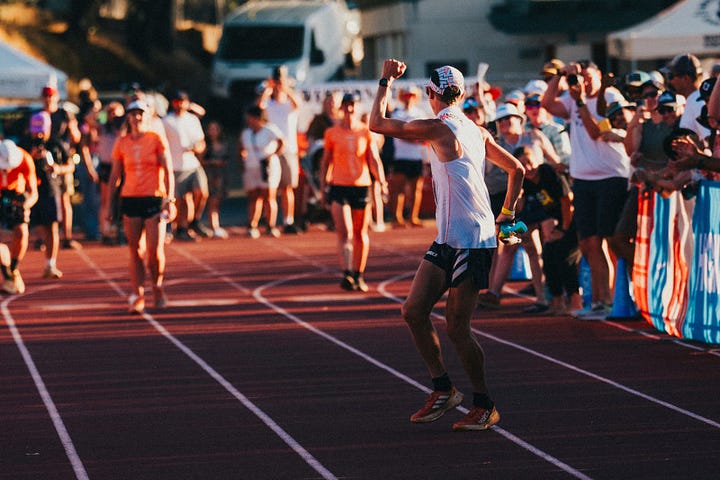It takes a team! As a final reflection on Western States, I want to touch on a couple things:
Support Crew specifics at Western States. Their perspective and mine.
What I believe to be important factors for support crews in all races.
Side Note: Our Lessons From the Long Run team, is almost at 1000 members. Thank you all so much! If there’s a friend, family member or colleague that could benefit from these weekly emails. Let’s get them in the mix!
The really nice thing about Western States is that there is no support crew limit. You can have a designated person to rub your feet at an aid station (if that's what you are into), and everything in between. For my crew, it was all about efficiency. Akin to an F1 pitstop, everyone had a designated job and set about completing it as quickly as possible.
We had:
the cooling crew,
the hydration/fuelling person,
the camera crew (crucial),
then a couple people yelling out a bit of course and gaps intel.
All of these are really important, and by all accounts, it is quite stressful for the team involved. Michelle has relayed this to me numerous times in post-race debriefs. Even describing it to me as being more stressful than racing! I guess it’s similar to when you hear a sports player become a coach, and say that coaching is more stressful than playing. You can only control so much as the support crew, but it’s important that you all work together as a team in those crucial aid station moments.
The things that I sometimes fail to appreciate are the logistics and getting between aid stations. So if you ever run Western States, these are important things to note:
2 crews with a car each is necessary if you want crewed help at all available aid stations
It's at least a 2 hour drive between the start and the first aid station.
You're going to want a chilly bin (AKA cooler) and ideally ice to keep things chilled and to douse at aid stations.
Your crew need to be reasonably fit as some aid stations require a couple of km’s of walking from parking areas.
But with all this in mind, the support crew also has to be prepared for anything. We had one of our camera crew get a flat tyre. The team proceeded to change it and make the run down to Ruck-a-Chuckee Aid Station to only miss me by a few minutes.
At the same aid station there was a forest fire in the area. It was very lucky that the fire crew got things under control and the race was able to continue. But for a brief time crews had to contend with the potential that they wouldn’t be able to help their runner come through and worse the race being stopped.
You can imagine it. What a disaster that could have been. 30km to go and get dragged off the course. But no, we were all able to carry on.
A cool thing about Western States is that your support crew is able to join you at Robbie Point. With 1 mile to go you can run the last section together, right through to finish on Placer High School track. It's an amazing feeling to share that experience with those that helped you get there. There is always an overwhelming feeling of gratitude and it makes you appreciate the whole team effort that helped you reach your finish-line.


Here’s a few important considerations for your next ultra (that requires a support crew)
1. Have a crew meeting with everyone to talk through the ‘game plan’. If this can’t be done in person, I will record a video for people. Then it’s bagging up nutrition and what is needed at each aid station. Writing out clear instructions of what is going to occur at each aid station, and also backing up with a video.
2. Be clear on the type of information you need from your support crew. Some people may be interested in the gap between who’s ahead or behind. While some people may be more concerned with cut-offs. It is always a nice reminder about the distance to the next aid station as well. This can get difficult to remember in the heat of the race.
3. The role of your pacer, this could be what gets you to your goal or not. It’s always nice to know your pacer before race day. Letting them know your goals, how you like to receive communication, what you need from them etc. Besides general encouragement to keep moving, a pacer can help by reminding you to eat/drink every 20 minutes. Then break down the course in front of you to a more granular level than what you can remember. The more they know about the course the better.
Hopefully that helps!
What’s next for me?
The next race I have coming up is CCC. In contrast to Western States, the support crew at UTMB is a one person support operation. It's a bit of a different vibe arriving into aid stations. But I had a very positive experience at UTMB last year. Where my good mate, and Western States 3rd place getter, Hayden Hawks supported me.
Potentially the CCC 100km distance might carry a bit more urgency being a shorter race where the timing of stops is more crucial in the outcome of the race.
But either way, I know that the support I get at CCC will be very much appreciated and probably just as, if not more stressful than racing 😉
Once again thanks so much for your support, if you’re not part of the team yet. It’d be great to have you join



I like the f1 pit stop analogy. It seems that your crew was pretty much dialed in.